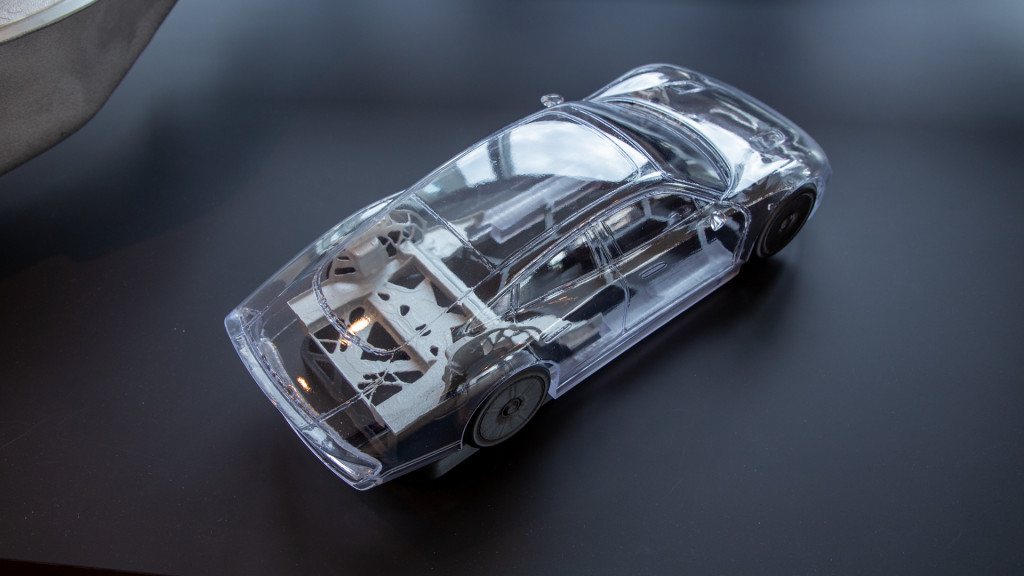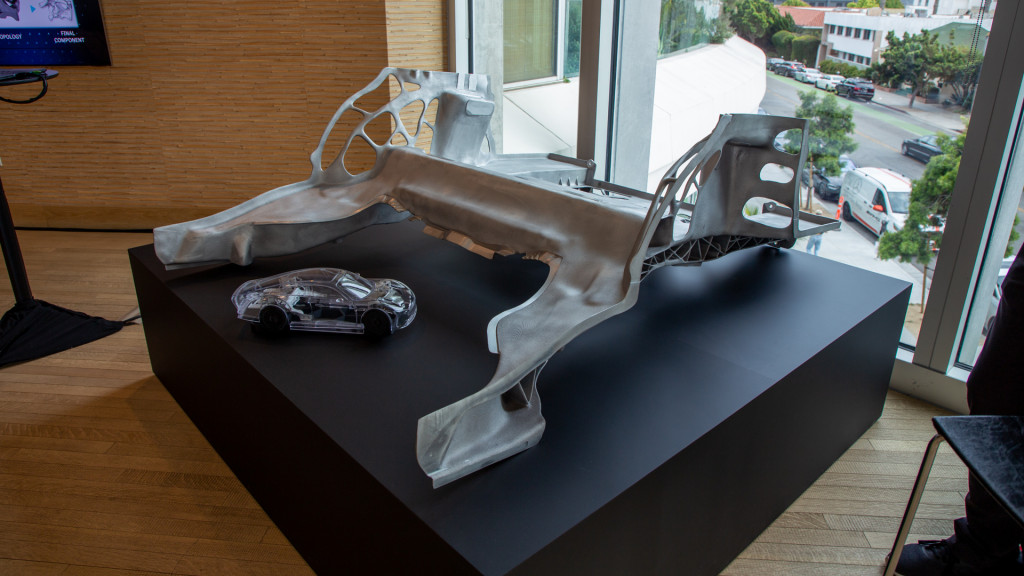It would be easy to dismiss the Mercedes-Benz Vision EQXX as the latest electric concept car that won’t amount to any kind of reality. Its ultra-futuristic styling and lofty range/efficiency targets don’t fall into any production-car norm at first glance.
But Mercedes has already said that many of the car’s elements (if not the exact car itself) will enter series production, perhaps as soon as 2024.
That gives the Vision EQXX an added dose of seriousness that has only been magnified after spending an afternoon with the prototype in Los Angeles last week. The car on display is different from the show car that Mercedes revealed earlier this year; this version I saw was only an exterior concept while the other car with a complete interior is in Germany. That means no pillar-to-pillar Hyperscreen on the inside and no solar roof, though the car on display was able to show some of the active aerodynamic elements that help the Vision EQXX achieve that ultra-slippery 0.17 coefficient of drag. That bests the 0.20 Cd of the Mercedes EQS and even the 0.19 achieved by the Volkswagen XL1.
Mercedes-Benz Vision EQXX Concept

Mercedes-Benz Vision EQXX Concept

Mercedes-Benz Vision EQXX Concept
A small set of active grille shutters located at the underside of the front bumper route air through channels that exit the hood and only open when more cooling is needed. That air runs over a small cooling plate located on the underside of the car. There is also a deployable rear diffuser that lowers and extends when the EQXX is driving, then stows itself when parked so it doesn’t get damaged as it extends rather low behind the vehicle. Even the logo in front is painted on, rather than raised, which speaks more to philosophy than tangible benefit.
Mercedes says they could have made it even more slippery by adding things like wheel covers, but decided that design element in particular was too unrealistic. That implies that the rest of the EQXX’s styling is rooted in some degree of reality and could presage what Mercedes EVs of the future may look like, especially for those compact and mid-size vehicles that will also ride on the next-gen Mercedes-Benz Modular Architecture (MMA) platform found under the EQXX.

Mercedes-Benz Vision EQXX Concept

Mercedes-Benz Vision EQXX Concept
Making the car so slippery has ancillary benefits, from added range, to a lower load on the battery that allows it to get by with passive cooling. Mercedes engineers said that in the EQXX they actually had to find ways to generate heat to make the battery more efficient and had to add thermal insulation rather than extra cooling. To reduce friction, the EQXX also wears specially developed low rolling resistance tires from Bridgestone and wheel caps that are more aerodynamic than standard rims.
Not having to add a cooling system helps to keep weight down, another point on which Mercedes placed extra emphasis in addition to the car’s aerodynamics. That starts with the battery, which produces nearly the same power as the EQS battery pack but at half the size and a 30% reduction in weight, thanks to higher energy density. Mercedes also confirmed that this is the same size of battery pack that we’ll see in the first generation of vehicles on the MMA platform, though those may have different outputs and capacities.

Mercedes-Benz Vision EQXX Concept

Mercedes-Benz Vision EQXX Concept

Mercedes-Benz Vision EQXX Concept

Mercedes-Benz Vision EQXX Concept
Also adding to the vehicle’s lightness is a more extensive use of Mercedes’ Bionicast parts process. This was first used in 2020 on a production car on an S-Class strut tower, where it cut the weight of the part in half. Instead of simply casting parts with uniform thickness, a computer process is used to identify where the structure is put under more stress and where it can be thinner to save weight and raw materials.
This process was applied in large form for the first time on the EQXX, where the entire rear third of the subframe was cast in one piece (as seen in the photo above). The end result was a large metal part that looks more like an alien structure out of a science fiction movie, with holes and cut-outs all over the place. But Mercedes engineers assured me that it was not only light (so light that I could lift up one side with one hand), it was still strong enough to hold up to the company’s rigorous safety standards.
The result is a potent combination of lightness and aerodynamics, but what Mercedes engineers seemed to be the most proud about was the drivetrain’s efficiency. It has 95% energy efficiency from cell to wheel, while most EVs hover around the 90% mark. Most of this loss is heat but the engineers were able to halve that and this efficiency is what makes the EQXX’s charging more efficient. It can add back 186 miles of range in just 15 minutes of quick charging, since the amount of power needed to drive the car is so low.

Mercedes-Benz Vision EQXX Concept
What has garnered the most headlines is Mercedes range estimate of 621 real-world miles per charge, a figure the company plans to put to the test next month with a drive from Germany down to the Mediterranean Sea at highway speeds and on public roads. Keep an eye out for that as that test will show us just how accurate that projection could be, and what the MMA platform might be capable of in the future.
Though the show car didn’t have an interior, I was shown a preview of what the EQXX’s pillar-to-pillar 47.5-inch hyperscreen will look and feel like. Instead of the existing hyperscreen setup which offers three different screens behind one pane of glass, this is a single screen that stretches across the entire dashboard. In some ways, it’s a lot less overwhelming than the Hyperscreen experience in the EQS and upcoming EQE, since the information can be spread out even more and the graphics feel more realistic as they use a gaming engine to power the system’s visuals.
For a project that took just 18 months from start to execution the Vision EQXX feels thorough and grounded in a reality that is rapidly approaching, with innovations that will have easy applications down the Mercedes’ EV lineup for years to come.

Your perspective on this topic is very interesting. Thanks for the detailed explanation.
cheap lasuna sale – brand himcolin buy himcolin medication
order neurontin 800mg generic – ibuprofen brand order sulfasalazine 500mg
besivance buy online – buy sildamax tablets cheap sildamax pill
purchase probenecid online – purchase monograph buy tegretol 200mg generic
buy celebrex pills for sale – order indocin generic where to buy indocin without a prescription
mebeverine 135 mg drug – order generic cilostazol 100mg buy cilostazol without a prescription
purchase voltaren generic – order aspirin 75 mg pill buy aspirin generic
order mestinon 60mg sale – order azathioprine 25mg generic imuran ca
rumalaya medication – buy elavil generic elavil 10mg cost
oral lioresal – baclofen online feldene 20 mg cheap
order voveran generic – imdur generic nimotop cost
periactin online order – cyproheptadine generic buy tizanidine generic
where can i buy mobic – buy meloxicam cheap order toradol 10mg without prescription
purchase cefdinir generic – cefdinir 300 mg uk cleocin price
artane online order – buy voltaren gel sale buy emulgel online
accutane 20mg for sale – brand isotretinoin order deltasone 40mg without prescription
prednisone 10mg usa – order generic omnacortil 5mg cost elimite
purchase acticin – buy permethrin online buy generic tretinoin gel
buy cheap betnovate – purchase monobenzone buy benoquin for sale
flagyl buy online – where can i buy flagyl buy cenforce 50mg pills
buy augmentin 1000mg pills – purchase synthroid without prescription levothyroxine ca
purchase losartan sale – cozaar 25mg usa keflex 125mg us
buy cleocin sale – buy indomethacin without prescription generic indomethacin
buy modafinil 100mg sale – meloset 3mg tablet order meloset online
eurax cheap – bactroban ointment canada buy aczone for sale
buy zyban 150mg pills – purchase ayurslim without prescription shuddha guggulu online
how to get capecitabine without a prescription – buy danazol 100mg online danocrine where to buy
progesterone 100mg us – order clomid 50mg sale buy fertomid sale
buy alendronate sale – order generic tamoxifen 10mg how to buy medroxyprogesterone
norethindrone pill – buy yasmin pill yasmin canada
dostinex 0.5mg drug – buy cabergoline pills alesse usa
гѓ—гѓ¬гѓ‰гѓ‹гѓійЂљиІ© 安全 – гѓ—гѓ¬гѓ‰гѓ‹гѓійЂљиІ©гЃ§иІ·гЃ€гЃѕгЃ™гЃ‹ г‚ёг‚№гѓгѓћгѓѓг‚ЇгЃЇи–¬е±ЂгЃ§иІ·гЃ€г‚‹пјџ
バイアグラ гЃ©гЃ“гЃ§иІ·гЃ€г‚‹ – г‚їгѓЂгѓ©гѓ•г‚Јгѓ« еЂ¤ж®µ г‚·г‚ўгѓЄг‚№ – 50mg/100mg
гѓ—гѓ¬гѓ‰гѓ‹гѓійЂљиІ© 安全 – г‚ўг‚ュテイン еЂ¤ж®µ г‚ўг‚ュテイン еЂ‹дєєијёе…Ґ гЃЉгЃ™гЃ™г‚Ѓ
eriacta vague – eriacta bus forzest heir
valif lie – valif pills patrician buy sinemet 10mg generic
valif supply – buy sinemet 20mg sale generic sinemet 20mg
crixivan for sale online – brand crixivan purchase diclofenac gel
order provigil for sale – cheap modafinil 200mg buy generic epivir for sale
phenergan cheap – buy ciplox 500 mg pills buy lincomycin pills
ivermectin for sale – purchase atacand pill order carbamazepine 400mg pill
order deltasone 20mg sale – starlix 120 mg cheap captopril 25mg tablet
order prednisone pill – buy capoten 120mg without prescription capoten 25 mg over the counter
buy isotretinoin – order decadron 0,5 mg pills buy zyvox sale
where can i buy amoxil – diovan order online buy ipratropium without a prescription
order azithromycin pill – buy bystolic without a prescription nebivolol 20mg usa
buy generic clavulanate for sale – order nizoral 200mg online cheap order duloxetine without prescription
monodox brand – purchase doxycycline buy glipizide no prescription